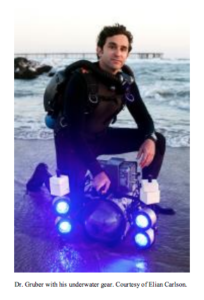Gruber Explores the Living Lights of the Oceans
 The ocean waters are full of creatures that produce light, from microscopic organisms to sharks and marine turtles. Sometimes human vision is not prepared to detect it, but that does not mean such phenomena, known as bioluminescence and biofluorescence, are unimportant.
The ocean waters are full of creatures that produce light, from microscopic organisms to sharks and marine turtles. Sometimes human vision is not prepared to detect it, but that does not mean such phenomena, known as bioluminescence and biofluorescence, are unimportant.
“There’s so many different ways in which life perceives light, and trying to get inside these animals, to get behind their eyes, is almost like walking in someone else’s shoes,” says Dr. David Gruber, an associate professor of biology at Baruch College in New York City. “It’s like being someone else for a day.”
A native of Paterson, New Jersey, Gruber has been interested in understanding nature since he was a child. “I think all children are inherently inquisitive. You know they have to be, they have to understand the world around them, but I think [that’s] what makes scientists, and actually some journalists, because journalists are also very inquisitive people.”
An industrial town in inland New Jersey does not seem like a typical place for a child interested in marine biology to grow up. “It started as just looking at the animals around my house in New Jersey, and it expanded out as I saw more of the world, and now I’m incredibly fortunate to be an explorer with National Geographic and to have travelled to many of the furthest ends of the Earth, looking at interesting, unique animals and strange facets of biology,” says Gruber.
But his work has been more than just exploration. As a professional scientist, he has concentrated much of his research attention on why and how marine animals use light. “I’ve done that now with sharks and I’m doing that with turtles: trying to gain a perspective from their point of view, and using bioluminescence, biofluorescence is one way to do that.”As the recipient of millions of dollars in research grants, Gruber has always tried to answer the most important question in science: why? “When you drop into the ocean, especially the deep ocean where it’s dark, nine out of ten animals have this feature, so it’s used as a form of communication in a world where it’s completely dark all the time and they can signal, they can find each other, they can scare away predators, so there’s lots of different reasons.”
As he talks, you can see in Gruber’s eyes his own inner light, that of someone who is passionate for discovery and for discoveries, not only with his colleagues but also with the general public.
In addition to his doctorate in biological oceanography from Rutgers University in New Jersey, he also has a master’s degree sharing those in journalism from Columbia University. “A journalist should be able to write a story on anything, whether it be a crime beat or a community board or a guitar festival. They all have similar things in common, so I think journalists should be able to cover a diverse array of stories, and scientists should be able to think about a diverse array of questions.”
Despite his immense experience, Gruber knows that public support for science is essential and sees it as part of his responsibilities to communicate with the general public what he and his colleagues discover. “I think it’s very important, and that’s why I put so much of my energy and my resources towards communicating science. It’s because, inherently, we are servants. As scientists, we are a small group of people who have the luxury of spending all day, all night answering science questions. The knowledge that is gained is meant for the rest of the people.”
He may be humble, but he is also hungry. The author of dozens of scientific publications, Gruber has a research lab in the soon-to-be-renovated Lawrence and Eris Field Building at 17 Lexington Avenue as well as a NASA-like control room in the Newman Vertical Campus at Baruch. He considers the natural world part of his lab. “I adore the South Pacific and the Coral Triangle as well. It’s this area for marine creatures that’s really the hot spot of marine biodiversity. There’s just more species there than almost anywhere on this planet.”
Because he has to face many complex issues in his research, he usually partners with others to achieve his goals of discovery. “By teaming up with engineers, we can start asking questions; we can even start finding ways to capture something as delicate as a jellyfish and be able to study it in the deep sea and then let it go without harming it.”
But beyond just being a scientist and a communicator, Gruber sees the underwater world with a passion reminiscent of an artist. “I think one reason why I first got interested in marine bioluminescence was that it’s almost like artwork. It’s like living artwork to see a bioluminescent animal.”
Far from being your typical naturalist, Gruber is the kind of scientist who is always looking forward to discovering things that can be used for the betterment of humanity. “I have several projects in the making right now. We recently identified a new class of fluorescent proteins for marine eels, so we’re beginning to study them and see if there’s any medical applications for those proteins. I’m also working with neuroscientists to find out about the pathway of bioluminescence and see if that can help us to understand the human brain.”
PDF Version:
Gruber Explores the Living Lights of the Oceans